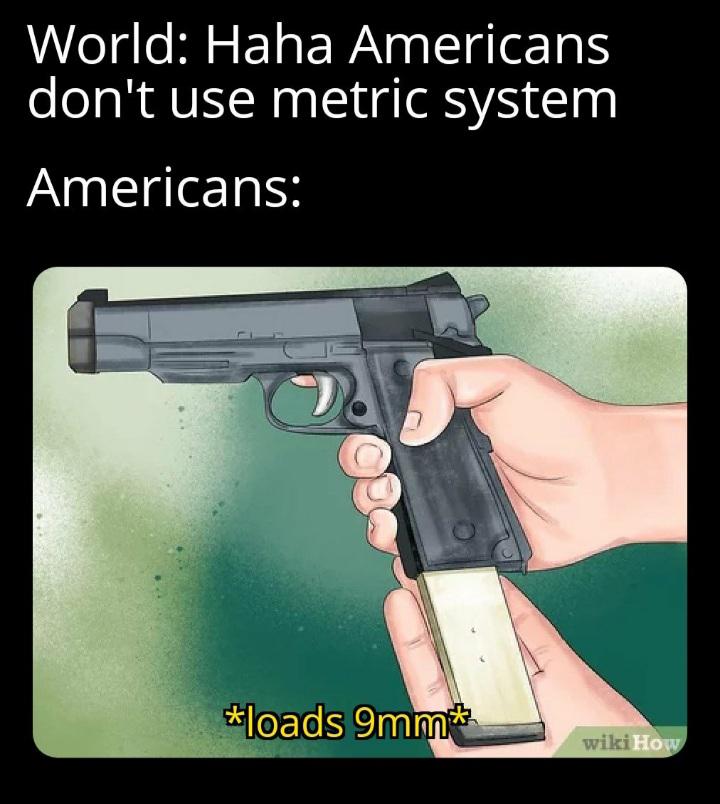
Don’t forget the most important US measurements of them all: 5.56, 7.62, 9, etc.
.308
Oh wait…
pls explain 🙂
.308 is caliber in inches thus not metric.
why do they use decimal for imperial units?
Because even people who worked in imperial recognized that dealing with stupid fractions is stupid.
Machining is often done in thousandths of an inch.
so why don’t they write 1/1000 in then?
Also, the imperial system is defined through the metric system.
In using imperial, you’re just using metric with extra steps.
No Python without C

Sounds like someone made a trip to the Levi’s store
Let’s not forget that the Apollo space program used SI units at every step, except for displaying it to the astronauts.
And that a very expensive probe crashed into mars instead of landing because NASA used metric for all measurements but one contractor didn’t get the memo.
- talking to my european friends
- talking to my african friends
- talking to my asian friends
- talking to my south american friends
- talking to my north american friends (exceptions apply)
- talking to my oceanian friends
- talking to my antarctican friends
Alright friend-haver, no need to flex that hard on us
Ayo the car thing is absolute bullshit.
10mm bolt for the fuckin brake caliper but 3/8 for the fuckin slide bolts?
Get the fuck outta here
GM has been using all metric for years now.
Don’t know what car you’re driving but I think you’re just using the wrong size wrench/Allen key
My last car was a 2012 ford fiesta. The lug nuts are 19mm. The caliper bolts were 10mm and the slide bolts were 3/8.
The car before that was a 2001 cavalier. Not only did it have metric and standard bolts but the slide bolts were fuckin Allen heads.
Like literally why?
Probably because they were made by American car manufacturers and couldn’t make a logical or consistent design decision if their lives depended on it.
When I was young I lived in Puerto Rico for a few years (1980’s). Milk was sold in either one litre cartons or one gallon jugs. Distances in road signs and road markers were in kilometers but speed was in miles per hour. Fuel was sold in litres but fuel usage is in miles per gallon.
I believe Canada and the UK do similarly.
Milk yes, car distance no, fuel usage no
Km and L/100km are used in Canada.
Do you say kilometers per litre or miles per gallon?
Edit: re-read. The UK still uses mpg, I believe
No, liters per 100 km, edited because I forgot the 100
But just to fuck with everyone we still refer to it a “mileage” in speech. Cause being a Canadian is suffering.
Seems like a good way to become proficient in both so that you’re more adaptable.
Nah. People just talked distances in fuel tank fractions, fuel dollars or travel time. For example, “how far is the mall?”, ‘about a quarter tank’. Or “how far is San Juan?”, ‘$5 will get you there’. Or " how far is Rio Grande" ’ about ten minutes that way’.
You forgot measuring bullets.
Bullets are a weird, dumb one. Yes, kind of. But also: .308, .303, .30-06, .50 BMG .30-30, .45-70, .38, .32, .44, .45, .50AE. Then nonsensically basically all “30 calibre” are the same diameter, which is exactly not quite .3 of an inch. Most of those are calibrated by the metric system (as many imperial measurements are today), but the terminology exists in the imperial system.
And then there’s fuckin gauges for shotguns smh.
Everyone uses guage descriptor for shotgun bores. It’s been around longer than the metric system. And it’s doubtful it will ever change.
Except .410 for some reason. I guess 67 gauge is starting to sound a bit crazy.
But yeah I know. I just think it’s silly.
While it’s pretty much traditional at this point, there was a very good reason for a long time to do it that way. Gauge for muskets/Fowlers is related to the number of round balls of bore diameter that weights 1 pound, (remember this predates the metric system by about 100+ years). And if you owned a firearm, you had to own the proper mold and cast your own lead balls to shoot over an open campfire. You just couldn’t pop down the the sporting goods store and buy some ready made round balls to shoot. Knowing how many round balls per pound lasted into the 1800’s. Because if you were a Longhunter or mountain man fur trapper, it was important to know that your .45 caliber Pennsylvania rifle shot 47 to the pound and a .50 caliber Hawken’s rifle shot about 35 round ball to the pound. so you could easily know how much lead you needed to bring with over the next year in the lonely mountains.
So if you owned a .72 caliber/12gauge musket you knew you would get 12 round balls per pound of lead. If you had a .69 caliber/14gauge, you would have 14 balls. A 20gauge/.62 caliber will give you 20 round balls.
But yes, the era of the metallic cartridges sent things off the rails in naming cartridges. And post WW1, everyone just completely lost the thread. We have .38 Short, Long, Special, and .357 - all the same bullet diameters. And a seemingly infinite number of .22 caliber cartridges that not even god himself can keep track of.
Weed to uses a mix in Canada
You buy grams until it reaches the point where you’ve bought an ounce and then you go up to buying a half pound or a pound…
Makes no fucking sense.
then you go up to buying a half pound or a pound
good, strong flex there.
I literally learned lessons on metric in public school
You didn’t have even liter of milk before school?
I did not
Oh, wow. You misseed out a lot. Are you lactose intolerant?
What?
What are you talking about with the weed? It’s sold in pounds, ounces, quarter ounces and “half quarters” which is as ridiculously un-metric as it gets.
My theory on this is we use the imperial weights when describing the size in relation to the jail time associated with getting caught with it and then switch to metric for personal use.
Sold in grams for small amounts, then back to Imperial for larger amounts.

Yes, the very metric package sizes using multiples of 7.
It doesn’t matter what the multiple is. It could be 28.35g exactly, it’s still metric because of the unit.
Their point was that while it’s using metric, all the available sizes are based on imperial amounts.

Yeah, but you still have work tool measurements in 5/8, 7/32, and 13/64 or whatever the fuck dumbass measurements.
I say this as an American that hates the way tools use measurments here.
I specifically prefer woodworking in fractional inches. I’ve had this argument on Lemmy before and it basically goes:
“But inches bad! Metric good! Fractions bad! Powers of ten good!”
“I mean yeah okay but I nearly never have to divide by ten in the wood shop, I do have to divide by two or three or four, and since we mill stock to finished dimensions that are usually 3/2*x inches, most commonly 3/4” or 3/2" it’s trivial to do. Cutting mortise one third the board’s width in 3/4" stock ends up being exactly 1/4" wide. Easy. The metric world usually mills boards to 19mm, which is pretty close to 3/4" so it’s suitable for the same applications. Show me the line on a metric tape measure that indicates one third of 19mm."
“But Americans use inches so it must be dumb and bad!”
I use metric for quite a lot of things, I learned chemistry and physics in metric in school, I vastly prefer doing mechanical and engineering things in metric. I learned carpentry (structure building) in inches but I could cope with metric there, I learned how to fly in mostly US customary units (distances in nautical miles, speeds in nautical miles per hour aka knots, altitude and runway lengths in feet, pressures in PSI, temperature in °C) I could cope with different units there. I’m not giving up inches in the furniture shop though, because working in fractions works to well.
But yeah the faster we can erase fractional inch wrenches from the world the better. “What’s one size louder than 3/4?” “Ah shit 6/8…12/16, plus 1…13/16.”
Except there’s an easy way to mark thirds: if you have a, let’s say, 27 cm wide board you take the measuring by skewing a little the tape and measuring 30 cm. You mark 10 cm and 20 cm and there you have it: a third of the wide. You don’t even need the precise measure. If you have something with proportional marks you just use it and you get a third no matter the width. It’s like a center finder but with thirds (or fourths or…)
That will likely work for the length or width of boards, but what about thickness? Mark out a mortise and tenon on a 19mm thick board with that technique and tell me how it goes.
This is the kind of shit I’m talking about. You see these kinds of “Nuh uh, it’s not a problem, you just learn all these hacky workarounds” excuses out of the inch-ounce crowd, where you “just have different measuring cups for that” or “our butter packaging has tablespoon markings on it” but in the wood shop it’s the other way around because the physical tasks are inherently easier to express as fractions rather than decimals, so I’m the one saying “I just measure it with my tape measure or combo square or ruler and it’s right.” and the metric crowd keep going “Nuh uh, it’s not a problem, you just learn all these hacky workarounds.”
Or you can do a division and that’s it.
19mm / 3 = 6.3333mm. Come on over here and show me the six point three three three three millimeter line on my metric tape measure.
2" / 3 = 0.666666666 Show me that point in you tape measure 😜
And both cases can be fixed by just skewing a little the tape (19 mm -> 21 mm and 2" -> 2.1". Close to 20°)
2 inches isn’t a common size for stock. 1.5 inches is though.
And you want to come show me 2.1" on my standard tape measure?
The army uses metric almost exclusively. It’s where I learned it.
Except in electronics. Everything is still .1 inch headers. We invented too many electronics and it’s stuck now.
It is also annoying that the electronics industry prefers the term “mil” for 1 thousands of an inch. Why not use “thou” like machinist use?
Yep. One “klick” is one km.
I think the main problem US people have with metric is their aversion to anything that has more than two syllables.
Far worse: It’s laziness.
I was teaching a friend how to make ravioli (yes, really) from the class I took while over in Italy. I bring my scale to measure the dough and the first thing she does is use the scale to get the right measurements and then, scrapes the contents into an imperial measuring cup. Worse, she was totally pissed when the semolina was not a perfect match to the 00 flour (mass and all that).
She is a tried and true American. She just wants to whip out her 1 cup without measuring weight and can’t fathom why the dough just “wasn’t like I taught her”.
By the way, the super secret Italian recipe is this: Ingredients per 2 people (spaghetti or tagliatelle) 100 grams total of: 50% white superfine flour 50% semolina Add 1 egg per 100 grams of flour
For ravioli, you want more superfine (00) flour so the pasta sticks together better. So like above, 100 grams total of: 60% superfine flour 40% semolina
Add 1 egg per 100 grams of flour.
But I want it to be one cup of egg!
Medium or large eggs, (the most common size) is about 5 eggs per cup, 4 per cup of extra large. - YMMV slightly depending the exact eggs your have.
Of course there’s a cup measurement for eggs.
What was I thinking.
Go for it
What most people miss about weight vs volumetric measurement when cooking is that it’s all about ratios. And if you had been paying attention in math class, you would know that ratios are unit less. Which means as long as you keep the proper ratio between the ingredients, it matters not one whit on how you measure them. You can weight, you can use cups or spoons or handfuls and pinches to achieve the correct ratio. You even demonstrate this by stating that the ratio of flour to semolina is 1:1 or 3:2 depending on the end use. And one extra large egg, (about 55 grams or 2oz), should make for a decent conversion.
But before you change units of measure, you need to be sure that the changes still hold to with the tolerances of the recipe. Something most people can’t do very well - much like your friend.
And never forget - the true masters of fresh pasta making at home are all those little old Italian Grandmothers. And they are probably just eyballing it all anyway.
Which means as long as you keep the proper ratio between the ingredients, it matters not one whit on how you measure them. You can weight, you can use cups or spoons or handfuls and pinches to achieve the correct ratio.
The problem with converting a 1:1 ratio of ingredients measured by weight and a 1:1 ratio of ingredients measured by volume is density. Two different kinds of flour may pack differently and thus have different densities enough to effect the consistency of the dough. And with something like flour, a cup of sifted flour is less wheat and more air than a cup of scooped flour.
In the UK, weed is measured in authentic receding British imperial units where an ounce weighs one less gram every year.
Hah, nice
fucking go to space
There was that one time where a NASA mission was ruined because they used the wrong units
Mars climate orbiter.


















